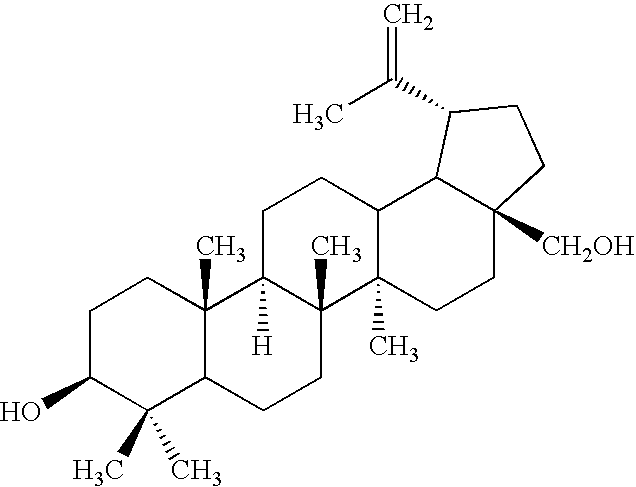Selective oxidation of triterpenes employing tempo
a triterpene and selective oxidation technology, applied in the direction of steroids, organic chemistry, etc., can solve the problems of unfavorable commercial scale (e.g., kilogram) production of betulinic acid, hazardous and expensive process use solvents and reagents, and inability to disclose purification steps, etc., to achieve cost-effective, safe and efficient, cost-effective
- Summary
- Abstract
- Description
- Claims
- Application Information
AI Technical Summary
Benefits of technology
Problems solved by technology
Method used
Image
Examples
example 1
Preparation of Betulinic Aldehyde
[0082]Betulin (0.2 g) was loaded into a round bottom flask together with TEMPO (25 mg), CH2Cl2 (3 mL), aqueous KH2PO4 solution (7 g / L, 3 mL), and t-BuOH (3 mL). 5 mL of oxidizing solution (5 mL of diluted bleach (bleach / water=1 / 1) mixed with 5 mL of aq. NaClO2 (4.57 g NaClO2 / 20 mL H2O)) was added with vigorous stirring. The mixture was stirred at room temperature overnight, organic and aqueous layers were separated. The aqueous layer was extracted with CH2Cl2 (3 times), the combined organic solution was washed with water 3 times and dried over anhydrous sodium sulfate. 60% yield of betulinic aldehyde was achieved after solvent removing and purification on silica (hexane / ether 1 / 1).
example 2
Preparation of Betulinic Acid
[0083]Betulinic aldehyde (0.73 g) was placed in a mixture of t-butyl alcohol (5 mL) and 2-methyl-2-butene (4 mL). The mixture was vigorously stirred until complete dissolution. The apparatus was places into a bowl, with ice and water (1 / 1). Then, a freshly prepared solution of sodium chlorite (NaClO2, 0.45 g in 4 mL of water) and dihydrogen potassium phosphate (0.68 g in 6 mL of water) were added at 20° C. during 0.5 hour under efficient stirring. Stirring at 20° C. was continued for 4 hours. Then the precipitate was filtered and washed 2× with 5 mL water and 5 mL of ethanol. Dichloromethane (8 mL) and water (7 mL) were added to the organic solution, shaken in a separatory funnel and the organic layer was separated. Betulinic acid (0.49 g, purity 96%+) was obtained.
example 3
Preparation of Betulinic Aldehyde 3-acetate
[0084]Betulin-3-acetate (0.4 g) was loaded into a round-bottom flask together with TEMPO (50 mg), CH2Cl2 (6 mL), aqueous KH2PO4 solution (7 g / L, 6 mL), and t-BuOH (6 mL). 10 mL of oxidizing solution (10 mL of diluted bleach (bleach / water=1 / 1) mixed with 10 mL of aq. NaClO2 (4.57 g NaClO2 / 20 mL H2O)) was added with vigorous stirring. The mixture was stirred at room temperature overnight, then organic and aqueous layers were separated. The aqueous layer was extracted with CH2Cl2 (3 times), the combined organic solution was washed with water 3 times and dried over anhydrous sodium sulfate. A 70% yield of betulinic aldehyde was achieved after solvent removal and purification on silica (hexane / ether 1 / 1).
PUM
| Property | Measurement | Unit |
|---|---|---|
| temperature | aaaaa | aaaaa |
| temperature | aaaaa | aaaaa |
| temperature | aaaaa | aaaaa |
Abstract
Description
Claims
Application Information
 Login to View More
Login to View More - R&D
- Intellectual Property
- Life Sciences
- Materials
- Tech Scout
- Unparalleled Data Quality
- Higher Quality Content
- 60% Fewer Hallucinations
Browse by: Latest US Patents, China's latest patents, Technical Efficacy Thesaurus, Application Domain, Technology Topic, Popular Technical Reports.
© 2025 PatSnap. All rights reserved.Legal|Privacy policy|Modern Slavery Act Transparency Statement|Sitemap|About US| Contact US: help@patsnap.com



